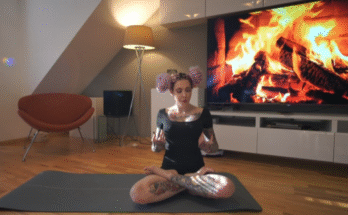
“Can you help me stretching?” These five simple words may sound like a casual request, but they reveal a deeper need that so many of us share: the desire to move better, feel better, and take better care of our bodies. Stretching isn’t just for dancers, gymnasts, or athletes—it’s something everyone can benefit from, especially in a world where we spend long hours sitting, scrolling, or working without moving much.
Why Stretching Matters
Stretching is more than just bending forward to touch your toes or pulling your arm across your chest. It’s a vital part of body maintenance. Regular stretching keeps muscles flexible, strong, and healthy. Without it, muscles shorten and become tight. When you ask someone, “Can you help me stretching?” you’re asking for help in caring for one of the most important tools you have—your body.
Many people only think about stretching after a workout or when they feel tightness or discomfort. But the truth is, stretching should be a regular part of our daily routine, just like brushing our teeth or drinking water. It prepares the body for movement and helps prevent injury. Even five to ten minutes a day can make a huge difference.

Common Stretching Mistakes
Before diving into a full routine, it’s important to avoid common mistakes:
- Bouncing While Stretching
Many people make the mistake of bouncing into a stretch. This can cause microtears in the muscle, leading to more tightness. The key is to move slowly and hold the stretch steadily. - Holding Your Breath
Breathing deeply helps your muscles relax. Inhale through the nose and exhale through the mouth during each stretch. - Skipping Warm-Up
Stretching cold muscles can be risky. It’s better to do some light movement, like walking or arm circles, before beginning a stretch routine. - Ignoring Your Limits
Stretching should never be painful. A stretch should feel like tension, not sharp pain. If it hurts, ease off.

Types of Stretching
When someone says, “Can you help me stretching?” it helps to understand the two main types:
- Static Stretching
This is the most common kind, where you hold a stretch for 20-60 seconds. It helps improve flexibility and is great for after workouts or at the end of the day. - Dynamic Stretching
This involves controlled movements that prepare your muscles for activity. It’s great before a workout or first thing in the morning.
A Simple Stretching Routine You Can Try
Let’s go through a basic full-body stretching routine you can do at home. This will take about 10–15 minutes and can be done with just a mat or soft surface.
1. Neck Stretch (Static)
- Sit or stand tall.
- Gently tilt your right ear toward your right shoulder.
- Hold for 20 seconds, then switch sides.
- This helps relieve tension in the neck from looking at screens.
2. Shoulder Rolls (Dynamic)
- Roll your shoulders backward in big circles for 10 seconds.
- Reverse direction for another 10 seconds.
- Loosens up the upper back and shoulders.
3. Arm Cross Stretch (Static)
- Bring your right arm across your body and hold it with your left hand.
- Hold for 20 seconds, then switch arms.
- Great for the shoulders and upper back.
4. Cat-Cow Pose (Dynamic)
- On all fours, arch your back upward (cat), then dip it down (cow).
- Move slowly with your breath for 30 seconds.
- Warms up the spine and improves flexibility.
5. Standing Forward Fold (Static)
- Stand tall, bend at your hips, and reach for your toes.
- Let your head hang and relax your back.
- Hold for 30 seconds.
- Stretches hamstrings, calves, and lower back.
6. Lunge with Twist (Dynamic/Static Combo)
- Step your right leg forward into a lunge.
- Place left hand on the ground, twist your torso to the right and reach your right arm up.
- Hold for 15 seconds, then switch sides.
- Opens up hips and thoracic spine.
7. Seated Hamstring Stretch (Static)
- Sit on the floor with one leg extended and the other bent.
- Reach toward the toes of the extended leg.
- Hold for 20–30 seconds, then switch legs.
- Improves flexibility in the back of the legs.
8. Butterfly Stretch (Static)
- Sit with soles of your feet together, knees out to the sides.
- Gently press knees toward the ground with your elbows.
- Hold for 30 seconds.
- Targets inner thighs and hips.
9. Child’s Pose (Static)
- Kneel on the floor, sit back on your heels, and stretch your arms forward.
- Relax here for 30–60 seconds.
- A relaxing stretch for the back, hips, and shoulders.
10. Ankle Circles (Dynamic)
- Sit or lie down and rotate each ankle in circles for 10 seconds per direction.
- Helps with mobility and balance.

Asking for Help is a Strength
There is no shame in asking, “Can you help me stretching?” In fact, it shows that you’re taking your wellness seriously. A partner can make stretching more effective and enjoyable. Partner stretches can add resistance, ensure proper form, and even provide emotional support.
If you’re unsure how to start, you can ask a yoga teacher, personal trainer, physical therapist, or even a flexible friend. There are also countless videos online for guided stretching routines.
Benefits of Stretching
When done consistently, stretching can:
- Increase flexibility and range of motion
- Improve posture and balance
- Reduce stress and promote relaxation
- Decrease muscle soreness after workouts
- Boost circulation and energy
- Support better sleep quality
And perhaps most importantly, it reconnects you with your body. In a busy world, stretching allows you to slow down, breathe, and focus inward.

Final Thoughts
So, the next time you feel stiff, sore, or sluggish, remember this article and ask yourself, “Can I help myself stretching?” The answer is always yes. And if you need guidance, don’t hesitate to ask someone: “Can you help me stretching?” Because in that moment, you’re not just asking for a physical favor—you’re inviting someone to be part of your wellness journey.
Stretching may seem simple, but it can be a powerful tool for healing, energy, and self-care. Take it slow, stay consistent, and enjoy the way your body starts to feel lighter, looser, and more alive.



